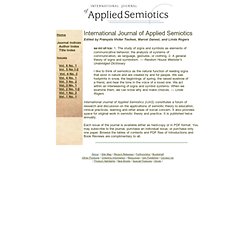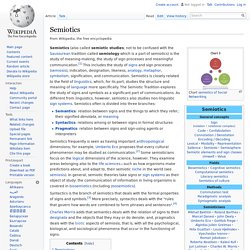

Signo. Applied Semiotics / Sémiotique appliquée. Applied Semiotics. International Journal of Applied Semiotics. International Journal of Applied Semiotics Edited by François Victor Tochon, Marcel Danesi, and Linda Rogers se·mi·ot·ics: 1.

The study of signs and symbols as elements of communicative behavior; the analysis of systems of communication, as language, gestures, or clothing. 2. A general theory of signs and symbolism. — Random House Webster’s Unabridged Dictionary I like to think of semiotics as the natural function of reading signs that exist in nature and are created by and for people. Semiotics. Semiotics frequently is seen as having important anthropological dimensions; for example, Umberto Eco proposes that every cultural phenomenon may be studied as communication.[2] Some semioticians focus on the logical dimensions of the science, however.

They examine areas belonging also to the life sciences – such as how organisms make predictions about, and adapt to, their semiotic niche in the world (see semiosis). In general, semiotic theories take signs or sign systems as their object of study: the communication of information in living organisms is covered in biosemiotics (including zoosemiotics). Syntactics is the branch of semiotics that deals with the formal properties of signs and symbols.[3] More precisely, syntactics deals with the "rules that govern how words are combined to form phrases and sentences".[4] Terminology[edit]